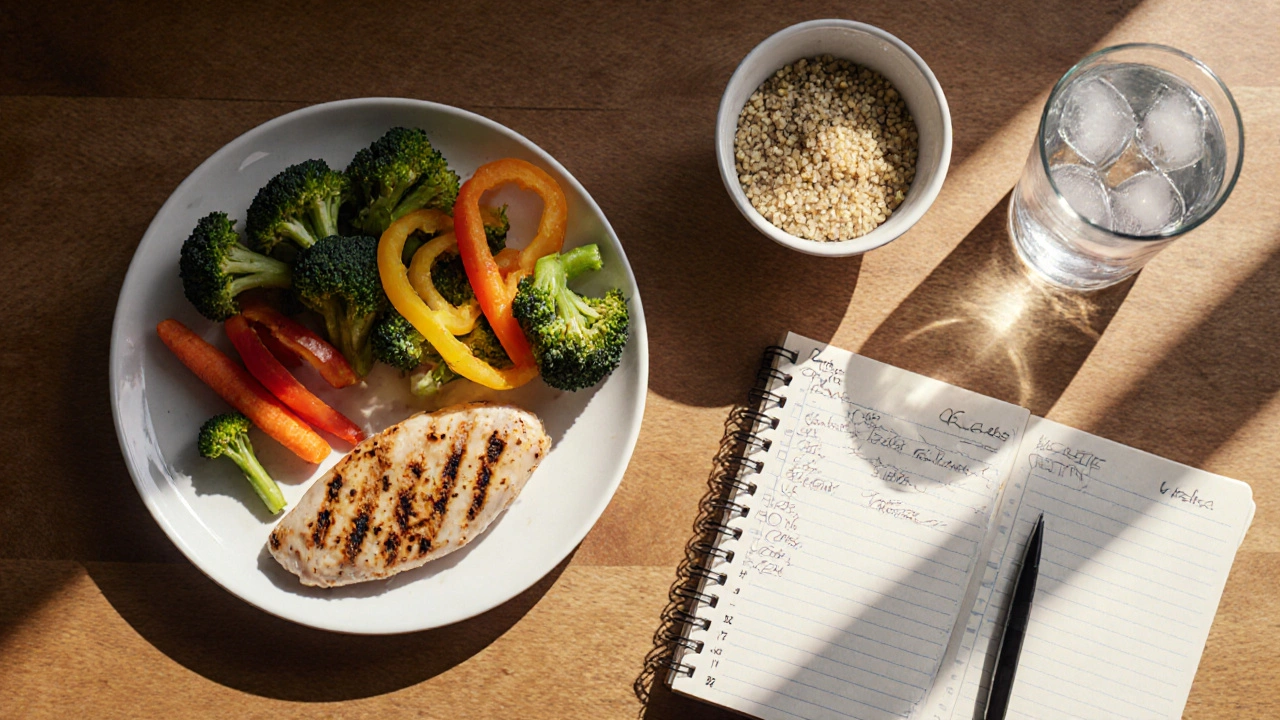Belly Fat Loss Tracker
Your Personalized Plan
Daily Calorie Deficit:
Recommended: 500-700 kcal/day for safe weight loss
Exercise Recommendations:
Quick Takeaways
- Create a daily calorie deficit of 500‑700kcal.
- Combine HIIT workouts with 30‑40minutes of steady cardio.
- Prioritise protein (1.2‑1.6g/kg body weight) and fibre‑rich carbs.
- Sleep 7‑9hours and manage stress to keep cortisol low.
- Stay hydrated - aim for 2‑3L of water daily.
Want to see a slimmer waist in only two weeks? It’s doable, but you have to treat the process like a short‑term sprint rather than a vague "diet". Below is a step‑by‑step plan that blends nutrition, exercise, and lifestyle tweaks. Follow each part and you’ll notice the belly area flattening fast - just remember the results hinge on consistency.
Lose belly fat means reducing the fat stored around the abdomen through a blend of calorie control, targeted exercise, and hormonal balance is the goal. To achieve it, you’ll need to understand how six key factors work together.
1. Set a Realistic Calorie Deficit
Weight loss boils down to calories‑in versus calories‑out. For most adults, a safe deficit is 500‑700kcal per day, which translates to about 0.5‑1kg of weight loss each week. Use a reliable online calculator or a fitness app to estimate your maintenance calories, then subtract the deficit.
Calorie deficit is the shortfall between the energy you consume and the energy your body burns forces your body to tap stored fat - including the stubborn belly stores.
2. Choose the Right Macros
Protein is your best friend. Aim for 1.2‑1.6g of protein per kilogram of body weight (about 90‑120g for a 70kg person). Protein preserves lean muscle while you cut calories, and a higher muscle mass boosts resting metabolic rate.
Carbohydrates should come from high‑fiber sources (vegetables, berries, whole grains) to keep insulin steady. Healthy fats (olive oil, avocado, nuts) provide satiety and support hormone health.
Protein intake supports muscle retention and increases thermic effect of food is especially crucial during a rapid‑loss phase.
3. HIIT - The Fat‑Burning Engine
High‑Intensity Interval Training (HIIT) spikes your heart rate, burns calories during the workout, and continues burning for hours after (the after‑burn effect). A typical session lasts 15‑20minutes and can be done 3‑4 times a week.
High‑intensity interval training alternates short bursts of maximal effort with brief recovery periods is proven to target visceral fat, the deep‑lying belly fat linked to health risks.

4. Add Steady‑State Cardio
Complement HIIT with 30‑40minutes of moderate‑intensity cardio (brisk walking, cycling, elliptical) on non‑HIIT days. This burns additional calories without over‑taxing recovery.
| Aspect | HIIT | Steady‑State |
|---|---|---|
| Duration per session | 15‑20min | 30‑40min |
| Calories burned (approx.) | 200‑300kcal | 250‑350kcal |
| After‑burn effect | High (up to 24h) | Low |
| Impact on muscle | Preserves / builds | Neutral |
| Best for beginners | Moderate | High |
5. Sleep - The Hidden Fat‑Loss Weapon
Insufficient sleep raises cortisol, a stress hormone that encourages belly fat storage. Aim for 7‑9hours of quality sleep. If you’re struggling, create a wind‑down routine: dim lights, no screens 30minutes before bed, and keep the room cool.
Sleep supports hormone regulation, muscle recovery, and metabolic health is as important as diet when you’re on a two‑week sprint.
6. Manage Stress Effectively
Stress triggers cortisol release, which fuels abdominal fat and makes cravings worse. Simple practices like 5‑minute breathing, short walks, or a quick yoga flow can keep cortisol in check.
Stress management reduces cortisol spikes and helps maintain consistent eating habits adds another layer of protection against belly fat.
7. Hydration Matters
Drinking enough water boosts metabolism by 10‑30% for about an hour after consumption. It also reduces false hunger signals. Aim for 2‑3L per day, and start each meal with a glass of water.
Hydration maintains cellular function and supports fat oxidation is a free, easy way to accelerate results.

Sample 2‑Week Action Plan
- Day 1‑3: 500kcal deficit, 30g protein per meal, HIIT (20min) + 10min core work, 8cups water, 8h sleep.
- Day 4‑5: Same deficit, steady‑state cardio (35min), add a fiber‑rich snack (apple + almond butter).
- Day 6‑7: Active recovery - brisk walk (45min), focus on stretching, keep protein high, practice 5‑minute breathing twice daily.
- Repeat weeks 2‑3: Increase HIIT intensity (shorter rest), swap one steady‑state day for a circuit (bodyweight squats, lunges, push‑ups). Maintain sleep and water targets.
Track progress with a simple waist measurement (in inches) every two days. Most people see a 1‑2inch reduction within the first week if they stick to the plan.
Common Pitfalls & How to Avoid Them
- Over‑restricting calories: Going below 1,200kcal can stall metabolism and cause muscle loss. Keep the deficit moderate.
- Skipping protein: Without enough protein, you risk losing lean tissue, which slows fat loss.
- Ignoring recovery: Too many HIIT sessions without rest can raise cortisol and increase injury risk.
- Relying on “quick‑fix” pills: No supplement magically melts belly fat in two weeks; focus on proven habits.
- Inconsistent water intake: Dehydration can masquerade as hunger, leading to extra snacking.
When to Expect Results
Because belly fat consists largely of visceral fat, it responds relatively quickly to calorie deficit and high‑intensity work. Most readers notice a flatter stomach, looser clothing, and better energy within 10‑12days. If you don’t see any change, double‑check your calorie counting and ensure you’re truly in a deficit.
Frequently Asked Questions
Can I lose belly fat without exercising?
Exercise accelerates fat loss, especially HIIT, but a strict calorie deficit combined with high protein can still reduce belly fat. However, results will be slower and you’ll miss the hormonal benefits of cardio.
Is it safe to aim for a 2‑week belly‑fat loss?
Yes, as long as you keep the deficit moderate (500‑700kcal) and maintain adequate protein, sleep, and hydration. Extreme fasting or crash diets can harm metabolism and should be avoided.
Should I count carbs while trying to lose belly fat?
Focus on quality, not elimination. Choose low‑glycemic carbs (sweet potatoes, oats, legumes) to keep insulin stable. Over‑restricting carbs can lower energy for HIIT sessions.
How much water should I drink each day?
Aim for 2‑3liters (8‑12 cups). If you’re sweating heavily during HIIT, add an extra 0.5‑1L to replace losses.
Will a low‑fat diet work better than low‑carb?
Both can work if calorie deficit is maintained. The key is to keep protein high and choose the macronutrient split that fits your lifestyle.
Stick to the plan, avoid shortcuts, and you’ll see a slimmer belly in just two weeks. Remember, the habits you build now can become the foundation for lasting health.





